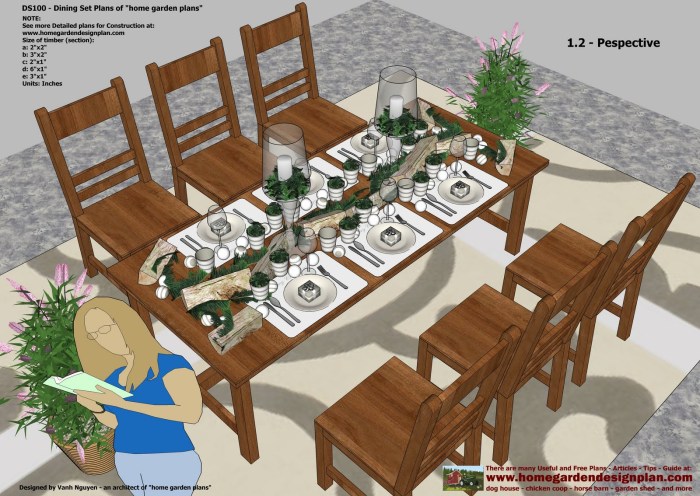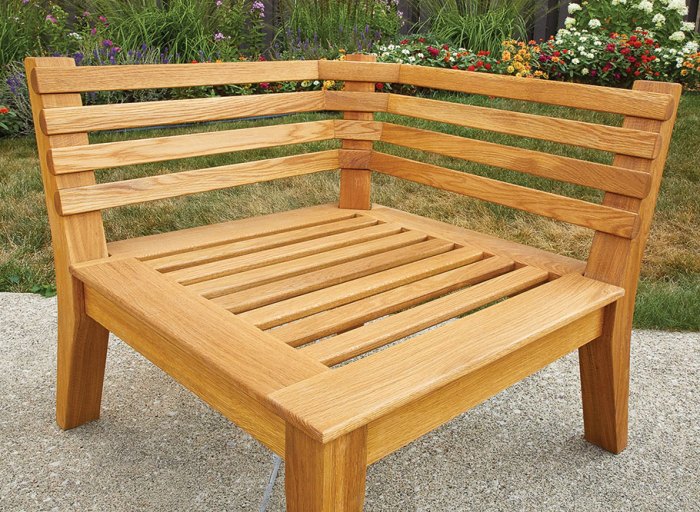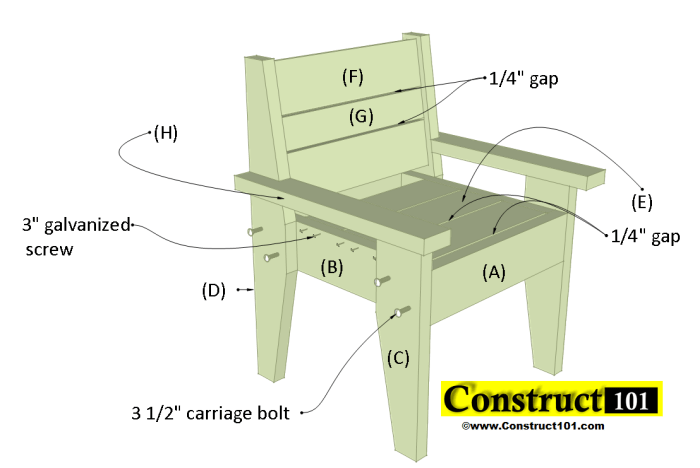Outdoor furniture plans open the door to creating a personalized oasis in your backyard. Whether you’re a seasoned DIYer or a beginner, building your own furniture offers a unique way to express your style and enjoy the outdoors. From stylish benches to sturdy tables, the possibilities are endless.
This guide will walk you through the entire process, from planning and material selection to construction and finishing. We’ll explore different types of plans, essential tools, and techniques to help you bring your outdoor furniture vision to life.
Building Your Outdoor Furniture

You’ve designed your outdoor furniture, gathered your materials, and now it’s time to get building! This section will guide you through the construction process, using a simple bench as an example. Remember, every project is unique, so adjust these steps to fit your specific design.
Preparing the Lumber
Before you start cutting and assembling, it’s essential to prepare your lumber. This includes:
- Inspecting the wood: Look for any cracks, knots, or warping. These imperfections can affect the strength and stability of your furniture. If you find any, you may want to choose different pieces or adjust your design to work around them.
- Sanding the wood: This will create a smooth surface for painting or staining, and will also help to prevent splinters. Start with a coarse-grit sandpaper and work your way up to a finer grit for a smoother finish.
- Applying a sealant: This will protect your wood from the elements and help to prevent weathering. Choose a sealant specifically designed for outdoor use.
Cutting the Lumber
Now that your lumber is prepared, you can start cutting it to size. This is where your plans will come in handy.
- Mark your cuts: Use a pencil and a ruler to mark your cuts precisely on the wood. Make sure to measure twice and cut once!
- Choose the right saw: Depending on the thickness of your lumber and the type of cuts you need to make, you may need a circular saw, a jigsaw, or a hand saw.
- Make clean cuts: A clean cut will ensure that your pieces fit together properly. If you’re using a power saw, make sure to use a sharp blade and to guide the saw carefully.
Assembling the Bench
With your lumber cut to size, you’re ready to assemble your bench.
- Join the pieces: Use wood glue and screws to join the pieces of your bench together. Make sure to use screws that are long enough to go through both pieces of wood and into the next.
- Pre-drill holes: Pre-drilling holes will prevent the wood from splitting when you drive in the screws.
- Secure the joints: Use clamps to hold the pieces together while the glue dries.
Finishing Touches
Once your bench is assembled, you can add some finishing touches.
- Sanding: Sand any rough edges or imperfections.
- Painting or staining: Choose a paint or stain that is suitable for outdoor use.
- Adding hardware: This may include things like hinges for a bench with a back, or legs for a table.
Finishing and Maintaining Your Outdoor Furniture

Your outdoor furniture is an investment, and proper finishing and maintenance will ensure it lasts for years to come. By applying a protective finish and taking steps to prevent damage, you can keep your furniture looking its best and enjoying it for many seasons.
Choosing the Right Finish
The type of finish you choose will depend on the material of your furniture and your desired look.
- Paint: A durable and versatile option, paint can be used to cover imperfections and create a fresh, new look. You can choose from a wide range of colors and finishes, including gloss, semi-gloss, matte, and eggshell. Be sure to use a paint specifically formulated for outdoor use, as it will be more resistant to fading and weathering.
- Stain: Stain is a great choice for highlighting the natural beauty of wood. It penetrates the wood, adding color and protection without hiding the grain. Stains come in a variety of colors and finishes, from transparent to semi-transparent to opaque. Look for stains that are specifically designed for outdoor use and offer UV protection.
- Sealer: A sealer provides a protective barrier against moisture, dirt, and UV rays. It can be applied over paint or stain to enhance durability and longevity. There are various types of sealers available, including polyurethane, acrylic, and oil-based. Choose a sealer that is compatible with the finish you’ve applied and offers the desired level of protection.
Protecting Your Furniture from the Elements, Outdoor furniture plans
Exposure to the elements can take a toll on outdoor furniture. Here are some tips to protect your furniture from rain, sun, and pests:
- Covering your furniture: Use a waterproof cover to protect your furniture from rain, snow, and dust. Choose a cover that is large enough to completely cover the furniture and made from a durable material that can withstand the elements. You can find covers specifically designed for different types of furniture, such as patio sets, chairs, and tables.
- Choosing the right location: Place your furniture in a location that is sheltered from direct sunlight and heavy rain. A covered patio or porch is ideal. If you don’t have a covered area, consider using an umbrella or awning to provide shade.
- Cleaning regularly: Clean your furniture regularly to remove dirt, debris, and mildew. Use a mild soap and water solution and avoid harsh chemicals that can damage the finish. If you have a wooden furniture set, consider using a wood cleaner to help maintain its natural beauty.
- Storing furniture during harsh weather: If you live in an area with extreme weather conditions, consider storing your furniture indoors during the winter or during periods of heavy rain or snow. This will help to extend the life of your furniture and prevent damage from the elements.
Maintaining Your Outdoor Furniture
With proper care and maintenance, your outdoor furniture can last for many years.
- Regular cleaning: Clean your furniture regularly to remove dirt, debris, and mildew. Use a mild soap and water solution and avoid harsh chemicals that can damage the finish. For wooden furniture, consider using a wood cleaner to help maintain its natural beauty.
- Re-applying the finish: Over time, the finish on your furniture will wear down and need to be re-applied. The frequency of re-application will depend on the type of finish, the amount of exposure to the elements, and the level of wear and tear. For painted furniture, you may need to re-paint every few years. For stained furniture, you may need to re-stain every one to two years. For sealed furniture, you may need to re-seal every year or two.
- Repairing damage: If your furniture is damaged, it’s important to repair it as soon as possible to prevent further damage. For minor scratches or dents, you can use a wood filler or touch-up paint. For more significant damage, you may need to contact a professional furniture repair service.
Summary: Outdoor Furniture Plans

Building your own outdoor furniture is a rewarding experience that allows you to create pieces that perfectly suit your space and style. By following the steps Artikeld in this guide, you can transform your backyard into a haven for relaxation and enjoyment. So, grab your tools, gather your materials, and get ready to build something amazing!
User Queries
What are the best materials for outdoor furniture?
The best materials depend on your needs and preferences. Wood is classic and durable, while metal offers longevity and low maintenance. Plastic is budget-friendly, and wicker provides a stylish, natural look. Consider factors like weather resistance, durability, and personal style.
How do I find free outdoor furniture plans?
Many websites offer free outdoor furniture plans. Search online for “free outdoor furniture plans” or explore sites like Ana White, Instructables, and Pinterest. You can also find plans in woodworking magazines and books.
What tools do I need to build outdoor furniture?
Essential tools include a saw, drill, sander, measuring tape, clamps, and a level. Depending on the project, you might need additional tools like a router, jigsaw, or nail gun. Always prioritize safety and use appropriate tools for the task at hand.
Outdoor furniture plans can be a great way to add some personal style to your outdoor space. If you’re looking for a fun and rewarding project, check out some do it yourself woodworking projects that can help you create beautiful and functional pieces.
From simple benches to elaborate tables, you’ll find plenty of inspiration for your next outdoor furniture project.
